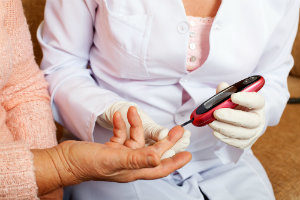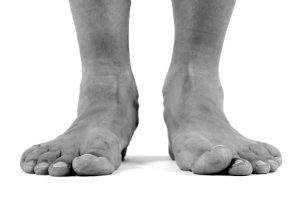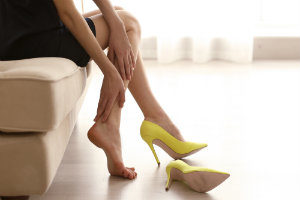


We may have just gotten out of National Diabetes Awareness month, but this disease needs to be given attention all year long. The number of Americans living with diabetes is staggering (29 million) and, even more concerning, it’s climbing. Effects on the body from the disease can be found, literally, from head to toe. It might be easy to think about ones like increased risk of heart attack, kidney failure, and potential blindness, but it would be a mistake to look past the link between diabetes and foot health.
Diabetes is a condition that develops on account of excessive blood sugar levels in the bloodstream. This happens when the body either doesn’t produce enough insulin—a hormone that allows the body to properly absorb and use sugar (glucose)—or it is unable to use the insulin effectively. In some cases, both of these problems exist at the same time.
The excess glucose in the blood can cause problems for most of the body’s organs and nerves. As we look at how diabetes affects foot health, skin is a central organ in the big picture.
Changes to the skin in the lower body can be an indication of a diabetic condition. These include more frequent callusing, increased itching sensations, loss of body hair, and shiny, thinning skin. Callusing is of particular concern since a callus can break down over time and become a diabetic ulcer.
Diabetic ulcers are extremely concerning. Ulceration is a breakdown of body tissue, which often results in open sores and wounds. These enable microorganisms (bacteria, fungus) to enter the body. Diabetes impairs the body’s ability to fight off infection, and a potentially serious situation can arise – gangrene. Gangrene is tissue death that cannot be treated. Instead, dead tissue needs to be removed in order to prevent it from spreading. Accordingly, this is a leading cause of lower limb amputations.
Two major conditions that play a role in diabetes and foot health are diabetic neuropathy and peripheral arterial disease (PAD). Neuropathy refers to the nerve damage that has taken place on account of the heightened glucose levels. This can leave an affected individual unable to tell when an issue exists, which then can lead to the problem worsening. PAD is a condition wherein blood vessels have become constricted and do not allow tissues to receive the oxygenated blood they need.
Diabetes can lead to severe consequences and problems for your lower limbs. If you live with this disease, come and see us as soon as possible so we can help you create a diabetic foot care plan to keep you safe. Schedule your appointment with our Bloomington, IN office by calling (812) 333-4422.
As with any field or specialty, podiatry has its own unique lexicon, and one of our goals is to help you understand and become familiar with terms like “pronation,” “gait,” and “biomechanical process.”
 Those particular terms relate to one another and have a rather strong connection. Pronation is an essential biomechanical process that takes place during your gait cycle, but let’s break this down and make it all a bit clearer for you!
Those particular terms relate to one another and have a rather strong connection. Pronation is an essential biomechanical process that takes place during your gait cycle, but let’s break this down and make it all a bit clearer for you!
To put it simply, a biomechanical process is when a living being (“bio”) moves (“mechanical”). Biomechanics are used in physical acts like jumping, swinging a baseball bat, kicking a soccer ball, throwing a football, and even simply walking. Your feet play essential roles for you, and they rely on biomechanical processes for different reasons, including absorbing the tremendous amounts of pressure and force they have to endure during the course of an average day (and even more when you perform high-impact activities).
When you walk (which is also known as your gait), your feet use an important process called pronation. As your foot pronates, it rotates inward roughly fifteen percent during the step. This takes place from the time the heel strikes as the foot comes down and then continues until the toes push off the ground. In part, this particular motion allows your foot to distribute all the physical force and stress—from walking and running—in an equitable manner.
This inward rotation not only helps the foot to absorb shock, but it also achieves optimal movement. When the foot strikes the ground, your arch flattens. You can think of this as being like a spring compressing and waiting for release. As your foot continues its roll, the arch decompresses and releases all of the built-up energy.
Now, the process is needed for distributing forces across the foot and assisting in forward movement, but there can be pronation problems. Feet that rotate either excessively (overpronation) or not enough (supination) can develop symptoms that may need to be addressed.
Overpronation results in excessive force being placed on the inner edge of the foot. Conversely, supination causes too much pressure on the outer edge. Often, overpronation is related to a flatfoot condition, whereas supination comes from high, rigid arches (cavus foot).
These issues can often be resolved with nonsurgical treatment, so come in and see us if you are experiencing pain from pronation issues! Contact our Bloomington, IN office by calling (812) 333-4422 or contact us online today.
When you see us for a foot or ankle problem, it is always our goal to resolve it for you with nonsurgical care. In some cases, we recommend surgery, but only when other options haven’t provided the results you hope to see. If we are recommending flatfoot surgery, you can rest assured knowing we have explored every other possible treatment first. You can also find comfort in the fact we are skilled and experienced in foot surgery.
In part, flatfoot surgery isn’t something to fear because it’s rarely needed. Treatment for flatfoot is actually only necessary when pain or difficulty arises due to the fallen arches. There are numerous instances wherein an individual has flat feet, but does not experience any issues. Obviously, there’s no need for treatment in these cases.
Patients with flatfoot issues can have pain and difficulty performing even routine, daily activities. We attempt to resolve these symptoms first with nonsurgical treatment options, to see if they improve the situation. These include treatments like medication, shoe inserts, custom orthotics, braces, rest, and physical therapy. The good news is that a combination of these treatment options is usually successful in providing relief.
For those rare cases when surgery is recommended, we start by completely evaluating your feet. This is used, in part, to determine if the fallen arches are stiff or flexible. We then use diagnostic imaging (typically X-rays) to create our surgical plan. The work we perform on the front end enables us to conduct a successful procedure for you.
Depending on variables that are specific to you, we may elect to either use regional or general anesthesia. No matter which we use, the intent is to ensure a painless procedure. Your comfort and safety are always a primary concern for us!
The specific surgical procedures used will depend, again, on variables specific to you and your condition. Whereas the actual procedures can vary, all flatfoot surgeries we perform have the ultimate goals of improving your walking ability and taking away your pain.
Flatfoot surgery does not entail a lengthy hospital stay. At most, you might need to stay overnight, although many patients go home the day of the procedure.
If you suffer from flatfoot pain, come see us at our Bloomington, IN office and we will create a treatment plan to provide the relief you need. Call us for more information at (812) 333-4422 or take advantage of our online form to connect with us today.
Between 2007 and 2009, our nation was mired in The Great Recession. During this time, people began to regain a sense of “value” when it comes to the things we buy and use. Thinking about value is an appropriate starting point when patients ask “Are orthotics worth the cost?”
To clear up a common economic misconception, the word “value” does not necessarily mean “cheap.” Cost is certainly a part of the picture, but you also need to look at what is received in exchange for the cost.
As an example, a pair of $200 jeans that lasts 10 years is actually a better value than having to buy a new pair of $25 jeans every year over the same time period (because the total cost is $250 in this case). Now, if those same $200 jeans only last 7 years, you are better buying the cheaper ones every year.
Beyond durability, though, you should also consider “function,” and this is important when discussing custom orthotics.
A common question we receive about orthotics is if you can just use one of the shoe inserts they sell at stores and pharmacies. Well, there are instances where you might benefit from the additional cushioning and arch support they provide, but keep in mind that mass-produced shoe inserts are not intended to correct medical problems.
When we prescribe custom orthotics, you receive valuable medical devices fully intended to address a problem you are experiencing. Further, these are customized to work with your unique foot structure and gait pattern.
Orthotic devices are also an investment in your health. The upfront cost might seem like a lot, but it is not nearly close to how much you would have to pay to address a bigger issue later. Aside from monetary concerns, custom orthotics can relieve pain and discomfort, and allow you to get back to your favorite activities, all of which are quality of life matter worth thinking about.
Hopefully you can see that if you are asking “Are orthotics worth the cost?”, the answer is a resounding “Absolutely!”
Whether we prescribe orthotic devices for you or not will depend on the condition affecting your foot or ankle. Come in and see us here at our Bloomington, IN podiatrist office so you can receive the care you need. Give us a call at (812) 333-4422 and our friendly staff will be glad to answer any questions or set you up with an appointment.
If you don’t have any issues with your feet, they simply do their job. However, understanding foot components and the roles they play—like when you spend time identifying your arch type—is useful for determining your risk factor for potential foot arch issues.
As we look at identifying foot arch issues, knowing which arch type you have is important. There are three types – moderate, low (flatfoot), and high (cavus foot). You can determine your style by examining your shoe wear patterns. Essentially, if you look at the bottoms of you r shoes and notice even wear, your arches are likely moderate in height. Excessive wear on the inner edge is a sign of low foot arches, whereas excessive wear on the outer edge can indicate high arches.
r shoes and notice even wear, your arches are likely moderate in height. Excessive wear on the inner edge is a sign of low foot arches, whereas excessive wear on the outer edge can indicate high arches.
The wet test is a matter of getting the bottom of your barefoot wet and then taking a normal step onto heavy paper or dry pavement. If your print consists of a front and back section connected by a strip about half the width of your foot, you have a moderate arch height. If the whole width is showing on the print, you have flat feet. On the other hand, a front and back connected by a thin strip, or even not connected at all, means your arch is high.
The importance of this in relation to identifying foot arch issues is that height plays a role in a biomechanical process known as pronation. Low foot arches lead to excessive roll and greater pressure on the inner edge of the foot. High arches cause supination (not enough roll) and the outer edge receives greater pressure.
Some foot arch issues are the problems caused by either being too low or too high, but sometimes the problem is what has caused the abnormal arch height in the first place. Weakened tissues in the feet—like the tendons, ligaments, and bones responsible for supporting the arch—can result in overuse injuries.
To address structural conditions and problems, we might prescribe custom orthotics. These are crafted to work specifically with your unique feet. Unlike over-the-counter shoe inserts, these prescribed devices are used in treatment for a medical issue. If you would like more information about this, or any of the services we provide at our Bloomington, IN podiatrist office, call (812) 333-4422 or use our online contact form today.
There are certainly many people who enjoy the Halloween holiday and get a kick out of those “things that go bump in the night.” Now, when you develop an abnormal bump on your foot, it can seem to be a scary situation. Knowing what is happening, though, can illuminate the situation and relieve your fears…just like using a flashlight in an otherwise dark basement!
Finding an abnormal bump on a foot might not be quite as frightening as some Halloween movies, but it is important to know what is happen and then have it addressed here at our Bloomington office. Some of the potential bumps you might develop include:
 schedule an appointment so we can provide the care you need!
schedule an appointment so we can provide the care you need!No matter if you need treatment for any of these conditions, or you would like more information, we are here to help! Give us a call at (812) 333-4422 or take advantage of our online form to contact with our Bloomington, IN office today.
Also, connect with us through social media so you can stay current with the latest in health news and tips! Like us on Facebook or follow us on Twitter and you will receive the health news you need.
There are many misconceptions in society, some of which include misunderstandings as to why bunions happen. Others include:
As we noted, another popular misconception is centered on the causes of bunions. Contrary to common belief, bunions are not caused by fashionable women’s shoes. Now, don’t get us wrong, footwear featuring narrow fronts and high heels do certainly contribute to an existing issue and lead to increased pain. The cause of a bunion, though, is more likely the result of:
 our foot, a bunion could potentially develop over time.
our foot, a bunion could potentially develop over time.No matter the root cause of your bunion, you should come and see us at our Bloomington, IN office if you have developed one of these common toe deformities. An untreated bunion will only worsen over time. Conservative methods can slow a bunion’s development and possibly ease symptoms, but we may recommend surgery to correct the deformity.
For more information about bunion treatment or our practice, either give us a call at (812) 333-4422 or contact us online today and we will be glad to help.
Choosing the right shoes for bunion pain is a lot like making sure you have the proper equipment for virtually any circumstance. You wouldn’t want to try hammering a nail with a dishrag or drying a plate with a hammer. We could spend all day coming up with other examples, but the basic fact is you need to have the right object to deal with the situation you are addressing. When it comes to reliving bunion pain, this includes making sure you are sporting certain kinds of footwear.
To start, let’s quickly rule out the wrong shoes. In this context, that means to avoid high heels, or at least limit how often you wear them. The bunion is protrusion on the inner edge of your foot, so narrow, tight shoes—like pumps or stilettos—can cause irritation and pain. Further, these particular styles place excessive pressure on the front of the foot, which can cause the condition to worsen.
It is worth noting that some people have the mistaken belief that high-heeled shoes cause bunions to develop. They can exacerbate the condition and lead to progression, but bunions typically develop as a result of inherited foot structure.
Whereas it is easy to single out high-heels as shoes to avoid, we should note that this really extends to any type of footwear that is too tight. Instead, the best shoes for relieving bunion pain are those which feature wide, deep toe boxes. The width is important for preventing friction or pressure on the bony protrusion, while depth is important for enabling the best possible range of motion for the affected joint.
It is always our preference to treat conditions with nonsurgical care whenever possible. In cases of bunions, this can include making sure you have the right shoes. Doing so will help you prevent the condition from worsening over time.
If you aren’t sure which shoes are the best ones for relieving bunion pain, we will be glad to help. Of course, you can contact us if you have any questions about this particular toe deformity or would like to schedule an appointment with our Bloomington, IN office. Bunion treatment is important because the condition is progressive, so call us at (812) 333-4422 or use our online form to connect with us right now.
It’s best to start this post by saying that we always hope all of our patients can be treated successfully with nonsurgical methods. Fortunately, we are able to use conservative care to effectively address a wide range of conditions for our patients. That being said, surgery sometimes is a necessary option, and this can be the case for bunions. Let’s take a look at this in case you are wondering “do I need bunion surgery?”
In order to determine if bunion surgery is right for you, it’s important to consider a couple of different factors. First, we want to ensure that conservative treatment methods have been adequately explored beforehand. If you are able to find sufficient relief with options like orthotics or bunion pads, then there is no need for a bunion surgery.
Individuals who are diabetic might not wish to risk the post-surgery complications that can arise from any surgery, but this is a matter we would discuss together. Other individuals who may wish to stay with conservative approaches include children, athletes, and those afflicted with other health issues.
You will know it is time to consider bunion surgery when:
No matter if you are a new patient, or have been coming to see us for years, we always provide the effective care and treatment you need for any foot or ankle problem causing pain or taking away your ability to perform favorite activities. Your first step, though, is to contact our Bloomington, IN podiatrist office. Simply give us a call at (812) 333-4422 or connect with us online today.
If you haven’t already started doing so, it’s about time to start thinking about the upcoming Halloween holiday. For various reasons—like parties and taking children trick-or-treating—you might dress up to celebrate with friends and families. No matter your costume of choice, you don’t want to experience pain and discomfort from a wart on the bottom of your foot. Fortunately, there are plantar wart prevention tips you can follow and, even better, they aren’t particularly complicated. 
Plantar warts can be particularly painful when you spend a significant amount of time on your feet, as is the case for parties and taking your children trick-or-treating. You don’t want a wart to develop before then—or at any time, really—so use the following tips to keep your feet wart-free:
We hope these plantar wart prevention tips are able to protect you, but eliminating all risk of the viral growths can be difficult. In the event you do end up with a wart on either of your feet, come see us at our Bloomington, IN podiatrist office and we will remove it for you, no matter if you’ve seen us before or are a new patient.
Give us a call at (812) 333-4422, or contact us online today, to request your appointment for exceptional foot care services.